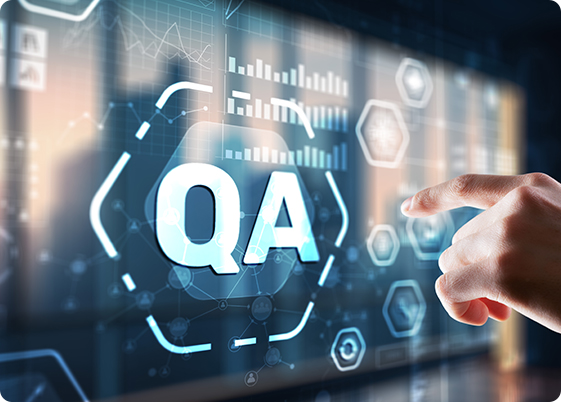
Call center quality assurance (QA) is vital in the high-volume customer service sector. It aims to provide sound, efficient, and satisfactory customer experiences. Call center managers, QA professionals, and business owners who implement effective QA programs often lead to measurable improvements in customer satisfaction and employee engagement.
This blog addresses questions like, what is quality assurance in a call center, why quality assurance is important in a call center, best practices and methods for improving call quality, and common issues you will face.
What is Quality Assurance in a Call Center?
Call center quality assurance is a systematic process of ensuring customer interactions meet predetermined standards, regulatory guidelines, and corporate policies. It monitors and measures incoming and outgoing calls to identify how many and how effectively customer concerns or issues are resolved.
The primary focus of call center QA is improving the customer experience through performance deficit area identification, agent training, and service delivery consistency. QA experts usually employ scoring rubrics, scripts, and customer satisfaction measurements to track parameters such as tone of voice, product knowledge, resolution, procedure follow-up, and empathy.
However, voice call center QA only covers part of the picture. It also deals with emails, chats, and other media in omnichannel contact centers. It also helps determine training requirements, enhances call scripts, and organizes internal workflows to improve the overall quality of service.
Contemporary QA initiatives will utilize analytics and AI offerings to measure call quality, allowing customer service quality assurance programs to provide real-time customer opinion feedback and reveal emerging service trends.

Why is Call Center Quality Assurance Necessary?
Understanding the role of quality assurance in a call center is crucial to any customer-oriented business. In outsourcing capitals such as the Philippines, the global leader in BPO cities, effective call center QA processes are an imperative to propel world-class service quality and customer satisfaction.
The reasons QA is needed are as follows:
- Ensures Consistency: QA ensures all customer interactions align with your organization's values and service level, resulting in consistent professional customer interactions.
- Enhances Customer Satisfaction: By monitoring calls and providing feedback, QA allows for faster, friendlier, and improved agent service, translating into more loyal, satisfied customers.
- Determines Performance Gaps: Regular quality audits detect performance gaps between agents in advance, allowing managers to take corrective actions before they affect service quality.
- Enhances Agent Development: Constructive criticism on QA check-in enlightens agents regarding their weaknesses and strengths, allowing for skill building and job satisfaction.
- Improves Operational Efficiency: QA provides feedback on agent behavior and call patterns, which assists managers in streamlining processes and maximizing team performance.
- Enables Regulatory Compliance: Ongoing monitoring guarantees agents comply with the law and industry standards, minimizing the probability of compliance mistakes or penalties.
- Fosters Ongoing Improvement: QA facilitates a culture of growth and accountability, wherein individuals and teams continuously work together to enhance the customer experience.
Types of Call Center Quality Assurance
Call center quality assurance can take several forms depending on when and how it is conducted. By recognizing these types, businesses can design a good, balanced QA plan to suit their needs.
- Reactive QA: Reactive QA involves listening to calls after they have been finished. QA professionals measure agent performance, detect gaps, and implement findings for coaching and process improvement. This can be beneficial for long-term development, but not for real-time adjustment.
- Proactive QA: Proactive QA is conducted in real time. Managers can intervene in real time and interrupt at key points to direct or escalate complaints. This strategy ensures service standards in key interactions and higher customer satisfaction.
- Automated QA: Automated QA leverages AI, speech analytics, and machine learning tools to review interactions in volume. It detects sentiment, keyword trends, and regulatory issues, enabling QA teams to handle volumes of information quickly and consistently.
- Hybrid QA: Hybrid QA combines human oversight with automation. It brings the human judgment required for advanced evaluations and relies on technology for velocity and scalability.
Each QA type has a role, and an equal balance will likely offer the optimum outcome in contemporary contact centers.

Best Practices for Call Center Quality Assurance
Organizations should follow disciplined QA best practices to achieve the best results. Below are the call center quality monitoring best practices:
- Establish Precise QA Standards: Develop a normalized QA scorecard with critical performance measures (KPIs), such as call resolution, tone of voice, script adherence, and empathy.
- Track Interactions Periodically: Track a random sample of complaint-based, high-risk calls to get an overall idea of the customer and agent experience.
- Provide Constructive Feedback: Provide timely, specific, and actionable feedback so that agents can know what they did right and how they can do better.
- Use QA Software Tools: Quality monitoring software effectively records, tracks, and stores interactions. It also assists in automating performance measurement.
- Train QA Analysts and Agents: Use real-life scenarios and examples to train QA staff and agents on the assessment standards.
- Enhance Agent Self-Audit: Encourage agents to review their calls and compare them against QA measures to promote responsibility and self-improvement.
- Focus QA Goals towards Business Plans: Permit QA endeavors to serve and support company goals such as client loyalty, policy compliance, and brand protection.
- Culture of Feedback: Create a feedback-friendly culture where agents feel safe to share and receive input.
- Continuous Quality Assurance Process Improvement: Refine the assessment criteria and coaching practices to align with changing customer expectations and industry best practices.
These quality assurance best practices call center use lead to long-term customer satisfaction and agent performance achievement.

Ways to Improve Call Center Quality Assurance
Even a strong QA program must evolve. Here’s how to improve quality assurance in a call center:
- Define Call Center Metrics: Establish the right performance metrics, such as First Call Resolution (FCR), Average Handle Time (AHT), Customer Satisfaction Score (CSAT), and Quality Score, to measure success.
- Customer Journey Mapping: Understanding the customer journey helps place calls in context and improve agent training. It also helps identify key pain points and service gaps.
- Real-Time Call Monitoring: Use live call monitoring to offer instant feedback and intervene during critical situations. This boosts customer satisfaction and helps agents feel supported.
- Automate Quality Management Workflows: Automating tasks like scorecard generation and reporting saves time, ensures consistency, and reduces human error.
- Reward Good Quality Assurance Initiatives: Incentivize top-performing agents and QA teams. Recognition drives motivation, reinforces good behavior, and encourages others to improve.
- Agent Training: Regular training sessions based on QA feedback help address knowledge gaps and improve communication skills, empathy, and problem-solving abilities.
- Integrate Omnichannel Insights in Your Call Processes: Customers interact via email, chat, calls, and social media. Ensure your QA process includes omnichannel evaluation to maintain consistency across touchpoints.
- Give Continuous Feedback: Don't wait for quarterly reviews. Provide feedback regularly. Real-time or weekly feedback helps agents make timely adjustments and fosters a growth mindset.
- Adopt a Customer-Centric Mindset: Shift the QA focus from checking boxes to genuinely improving the customer experience. Encourage agents to go beyond scripts and connect with customers empathetically.
These strategies can significantly improve call center QA and help organizations understand how to improve quality in call center environments while boosting team performance.

Challenges in Implementing Call Quality Assurance
While call quality assurance (QA) is essential for customer satisfaction and operational excellence, implementing it effectively comes with several challenges:
- Subjectivity in Evaluations: Different QA analysts may interpret the same call differently, leading to inconsistent scoring and biased evaluations.
- Lack of Standardized Metrics: Without clearly defined KPIs or scorecards, teams may struggle to measure quality objectively and uniformly across all agents.
- Limited Time and Resources: Manually reviewing every call is time-consuming. Many teams lack the manpower or tools to audit interactions at scale.
- Resistance from Agents: Agents may perceive QA as punitive rather than developmental, resulting in defensiveness and low engagement with the process.
- Keeping Up with Changing Customer Expectations: As customer preferences evolve, QA benchmarks must be regularly updated—something that’s often overlooked due to inertia or oversight.
- Inadequate Feedback Mechanisms: Delayed, vague, or unstructured feedback fails to support meaningful performance improvement.
- Technological Limitations: Outdated or incompatible QA systems hinder accurate call tracking, evaluation, and reporting.
- Data Overload: Given the high call volumes in many centers, it’s challenging to identify which calls to monitor without strategic sampling or AI support.
- Compliance Risks: If not all calls are monitored, there's a higher risk of non-compliance, increasing the risk of violations or missed red flags.
- Lack of Alignment Across Departments: Miscommunication between QA, training, and operations teams can result in inconsistent quality standards and ineffective coaching.
Overcoming these obstacles is critical for those learning how to improve call quality in BPO operations and maintain high service standards in any call center.
Conclusion
Call center quality assurance is more than a compliance measure—it catalyzes customer satisfaction, agent development, and operational success. Businesses can build a culture of excellence by following call center quality monitoring best practices, implementing ongoing improvements, and addressing challenges head-on.
In today’s competitive landscape, investing in QA is not optional—it’s a strategic necessity. Whether managing a small in-house team or a global BPO, a strong QA program is key to sustained success.
To explore more on customer experience strategies, visit our blog on Customer Needs Analysis and learn how to build good customer relationships.
At HGS Philippines, we are committed to delivering world-class customer support backed by a strong culture of quality assurance.
Ready to make a difference in customer service? Discover exciting customer service jobs with JoinHGS and join the customer-first revolution.
Frequently Asked Questions (FAQs)
What are the top 3 skills for a quality assurance specialist?
Communication skills, attention to detail, and analytical thinking are crucial. These enable a QA specialist to provide constructive feedback and derive insights from performance data.
How to become a QA analyst?
Start with a background in customer service or operations. Gain expertise in QA tools, learn to analyze data, and consider certifications such as Six Sigma or ISO 9001 in quality management.
What is the difference between quality assurance and quality analysis?
Quality assurance is the overall strategy to maintain service standards, while a quality analyst is a professional who monitors, evaluates, and reports on performance within that strategy.
What are the parameters of QA in a call center?
Typical QA parameters include call accuracy, compliance adherence, soft skills, script usage, resolution effectiveness, and customer satisfaction.
 Philippines
Philippines Canada
Canada Colombia
Colombia India
India Jamaica
Jamaica UK
UK US
US SA
SA



